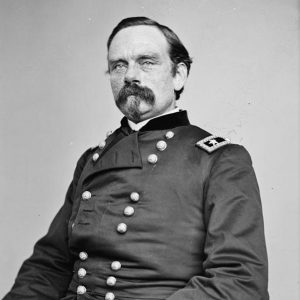calsfoundation@cals.org
Peter Joseph Osterhaus (1823–1917)
Peter Joseph Osterhaus was a German immigrant who rose through the ranks in the Civil War to the post of major general of volunteers in U.S. Army. He fought in several Trans-Mississippi battles, including Pea Ridge and Arkansas Post, and was the most accomplished of the German-born generals who fought for the Union.
Peter Joseph Osterhaus was born on January 4, 1823, in Koblenz, Prussia, the second of three sons of contractor Josef Adolf Oisterhusz and Eleanora Kraemer Oisterhusz, who chose to change their sons’ surnames to the German version. He received a military education and served in the Twenty-Ninth Reserve Regiment of the Prussian army.
Osterhaus was involved in the revolutions that convulsed Europe in 1848–1849 and was forced to flee to the United States with his family. They first settled in Belleville, Illinois, which had a large German American population. They later moved to Lebanon, Illinois, and then to St. Louis, Missouri, in late 1860. He trained with German American militias in St. Louis, even as pro-secession militias began parading in the city. As the prospect of Civil War grew closer, Osterhaus enlisted as a private in the Second Missouri Volunteer Infantry (US) and took part in the arrest of secessionists at Camp Jackson on May 10, 1861.
At the Battle of Wilson’s Creek in Missouri on August 10, 1861, Osterhaus served as major of the Second Missouri Infantry Battalion under Colonel Franz Sigel; his battalion suffered casualties of twenty-four percent as Union forces lost the battle.
In late December 1861, Osterhaus was promoted to colonel of the Twelfth Missouri Infantry Regiment (US) and was part of Brigadier General Samuel R. Curtis’s Army of the Southwest when it forced Sterling Price’s Missouri State Guard into northwestern Arkansas the following February. He commanded Curtis’s First Division under Brigadier General Franz Sigel and attacked Brigadier General Benjamin McCulloch’s Confederates at Leetown on the first day of the March 7–8, 1862, Battle of Pea Ridge. Osterhaus’s assault resulted in McCulloch’s death and effectively eliminated half of the rebel army from the battle; his actions there led to his promotion to brigadier general in June.
Osterhaus marched with Curtis’s army as it swept across eastern Arkansas to Helena (Phillips County), reaching there in July. He contracted malaria during the march and would suffer recurring bouts of that disease and dysentery for the rest of his life.
After convalescing in St. Louis, Osterhaus rejoined the army in time to participate in the attack on Arkansas Post on January 9–11, 1863, leading the land assault on Fort Hindman before Brigadier General Thomas J. Churchill and the entire Confederate garrison of the Arkansas River bastion surrendered. He led troops in actions around Vicksburg, Mississippi, suffering a serious thigh wound during the fighting at Big Black River.
Osterhaus commanded a division in the Union drive to force Confederates from Chattanooga, Tennessee, suffering one of his few defeats in an unsuccessful attempt to drive Major General Patrick Cleburne’s Confederates from Ringgold Gap, Georgia, on November 27, 1863. The following year, he served in the Atlanta Campaign, receiving promotion to major general on July 23, 1864. He led troops in Major General William T. Sherman’s March to the Sea after Atlanta was captured and briefly led a corps during the campaign to take the Carolinas.
In early 1865, Osterhaus commanded troops in the Union effort to capture Mobile, Alabama, which fell in April 1865. He was present when Lieutenant General Richard Taylor surrendered the last Confederate army east of the Mississippi River on May 4, 1865.
Following the war, Osterhaus oversaw Reconstruction efforts in Mississippi before being appointed U.S. Counsel in Lyon, France. He later returned to Germany, earning his citizenship in Baden in 1879. He came back to the United States in 1904, was feted by the Grand Army of the Republic, and had dinner with President Theodore Roosevelt. In March 1905, Congress gave him a slot in the retired list as a brigadier general in the regular army, and he was formally made a major general in the regular army ten years later.
Osterhaus died in Duisburg, Germany, on January 2, 1917, shortly before his adopted country declared war on Germany. He is buried in Koblenz.
For additional information:
Piston, William Garrett, and Richard W. Hatcher III. Wilson’s Creek: The Second Battle of the Civil War and the Men Who Fought It. Chapel Hill: University of North Carolina Press, 2000.
Shea, William L., and Earl J. Hess. Pea Ridge: Civil War Campaign in the West. Chapel Hill: University of North Carolina Press, 1992.
Townsend, Mary Bobbitt. Yankee Warhorse: A Biography of Major General Peter Osterhaus. Columbia: University of Missouri Press, 2010.
Warner, Ezra J. Generals in Blue: Lives of the Union Generals. Baton Rouge: Louisiana State University Press, 1964.
Mark K. Christ
Central Arkansas Library System


 Peter J. Osterhaus
Peter J. Osterhaus 



Comments
No comments on this entry yet.